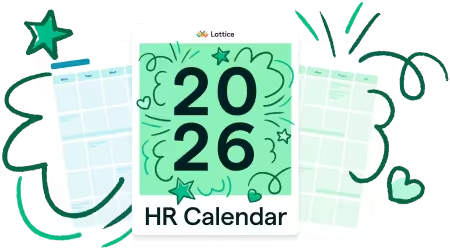Employee Retirement Policy Template


Download this template for free
By submitting your information, you agree to Lattice's Terms of Service and Privacy Policy. You can opt out anytime.
Thanks! We'll be in touch soon.
Retirement is a major life milestone — and an important transition for both the employee and the organization. Whether an employee has spent a few years or a few decades with the company, they deserve a respectful, well-organized offboarding experience that honors their contributions and helps ensure continuity for their team.
A clear employee retirement policy helps employees plan their exit, gives managers time to prepare for succession, and ensures the company handles benefits, compliance, and communications in a consistent and thoughtful way.
This policy outlines the company’s approach to voluntary retirements, including timelines, benefits coordination, knowledge transfer, and retirement celebrations.
What the Retirement Policy Should Include
An effective retirement policy should include:
- Purpose and scope: Why the policy exists and who it applies to
- Retirement eligibility: Age and/or tenure-based retirement guidelines (if applicable)
- Notice period expectations: How much advance notice is requested
- Resignation vs. retirement: How retirement differs from standard resignation
- Retirement process: How to notify the company, what happens during the transition
- Benefits guidance: What happens to health insurance, 401(k), PTO, etc.
- Knowledge transfer and transition planning: How roles and responsibilities are transitioned
- Retirement celebration or recognition: Optional acknowledgment of contributions
- At-will employment clarification: If applicable, reinforce that retirement is voluntary
Purpose of the Retirement Policy
This policy is designed to provide clarity and consistency for employees who are planning to retire. It ensures:
- Employees understand the steps and timing of retirement
- Managers have time to plan for a smooth handoff of responsibilities
- Final pay, benefits, and documentation are processed accurately
- The company celebrates and honors the contributions of retiring employees
Whether an employee is retiring at the end of a long career or transitioning into the next phase of life early, this policy helps ensure the process is fair, respectful, and well-supported.
Sample Employee Retirement Policy
{{rich-highlight-1}}
Effective Date: [Insert Date]
Policy Owner: People Team / HR Department
Last Reviewed: [Insert Date]
1. Policy Overview
This policy outlines the procedures for employees who intend to retire from their position at [Company Name]. It provides guidance on how to initiate the retirement process, what to expect during the transition, and how benefits and final pay will be handled.
This policy applies to all full-time and part-time employees who voluntarily choose to retire, regardless of role or department. It does not apply to involuntary separations or retirement as part of a company-wide layoff or reduction in force.
2. Retirement Eligibility
There is no mandatory retirement age at [Company Name]. Employees are eligible to retire when they choose, though many retire between the ages of 60 and 70 depending on personal circumstances, eligibility for Social Security or Medicare, or the terms of their retirement plan (e.g., 401(k) or pension).
Employees considering retirement are encouraged to speak with HR and a financial advisor to evaluate timing, benefits, and planning needs.
3. Notice Period
Employees planning to retire should notify the company in writing at least 30 to 60 days in advance of their planned retirement date. Longer notice is appreciated, especially for roles that require more complex transitions or succession planning.
The written notice should include:
- Intended retirement date (last day of work)
- Whether the employee is open to part-time or transitional support post-retirement (optional)
- Any flexibility around timing or final projects
4. How to Submit a Retirement Notice
Retirement notices should be submitted to the employee’s direct manager and copied to the People Team. HR will schedule a meeting to discuss next steps, benefits coordination, and offboarding logistics.
While retirement is similar to a resignation in that it is a voluntary exit, retirees may be eligible for certain benefits or recognition that are not available to standard resignations.
5. Transition and Knowledge Transfer
Once notice is given, the employee, their manager, and HR will work together on a transition plan that may include:
- Finalizing in-progress work or projects
- Documenting key processes or contacts
- Training or mentoring a successor (if one is identified)
- Coordinating final 1:1s or team handoffs
The goal is to ensure a seamless transition that minimizes disruption while honoring the retiring employee’s time and preferences.
{{rich-highlight-3}}
6. Final Pay and Benefits
Upon retirement, employees will receive:
- Final paycheck, including wages earned through the last day of work
- Payout of unused, accrued PTO in accordance with local law and the PTO policy
- Health insurance options, including COBRA continuation or Medicare enrollment guidance
- 401(k) and retirement plan information, including how to roll over or withdraw funds
- Any other separation documentation, such as proof of employment or exit forms
Employees are encouraged to speak with a benefits representative at least 30 days before their final day to review healthcare and retirement accounts.
7. Exit Interview
The People Team may offer an optional exit interview to gather feedback on the employee’s experience and identify opportunities for company improvement. This interview can also be an opportunity to reflect on career milestones and offer closure.
Participation is encouraged but not required.
8. Retirement Recognition
Depending on tenure and the employee’s preference, the company may offer:
- A written note of appreciation from the employee’s manager or department
- A retirement celebration (team lunch, virtual event, etc.)
- A commemorative gift or plaque (subject to company guidelines)
- A public thank-you in a company meeting or internal communication
All recognition efforts will be coordinated with the employee and kept in line with their wishes — some prefer a quiet send-off, while others enjoy a more celebratory goodbye.
9. Rehiring Retired Employees
Retired employees may be rehired on a part-time, project-based, or consulting basis if mutually agreed upon. The terms of re-engagement, including compensation and benefits eligibility, will be determined case by case and require executive approval.
Rehiring retirees may be subject to a waiting period depending on 401(k) plan rules and legal restrictions. Contact HR for more information.
10. Employment at Will
Unless otherwise stated in a written employment agreement, all employment is at-will. Employees may choose to retire at any time, with or without notice, and the company may also end employment at any time in accordance with applicable laws.
Frequently Asked Questions
1. What’s the difference between a resignation and a retirement?
Retirement is a voluntary departure typically associated with long-term service or age-based benefit eligibility. It may qualify you for additional benefits or recognition.
2. Is there a required retirement age?
No. Retirement is voluntary, and employees may choose to retire when they are financially and personally ready.
3. Do I have to use all my PTO before I retire?
Not necessarily. Unused PTO will be paid out in accordance with the company’s time-off policy and applicable state laws.
4. Will I still have access to company systems after I retire?
Access to internal systems will be deactivated on or shortly after your final working day unless otherwise approved for consulting or transitional work.
5. Can I return as a part-time or contract employee after retiring?
Possibly. Some teams may bring back retirees on a project basis. Talk to your manager and HR to explore your options.
{{rich-highlight-2}}
🚩 Please note: This sample policy is for informational purposes only and does not constitute legal or tax advice. It is a generic template that may not suit your specific circumstances. When adopting or revising a policy, consult legal counsel and a benefits administrator to ensure compliance with all applicable laws and regulations.
✨ Disclaimer: This resource was developed with the help of artificial intelligence, though reviewed, edited, and approved by (real) humans.
Frequently Asked Questions

Your people are your business
Ensure both are successful with Lattice.





.webp)